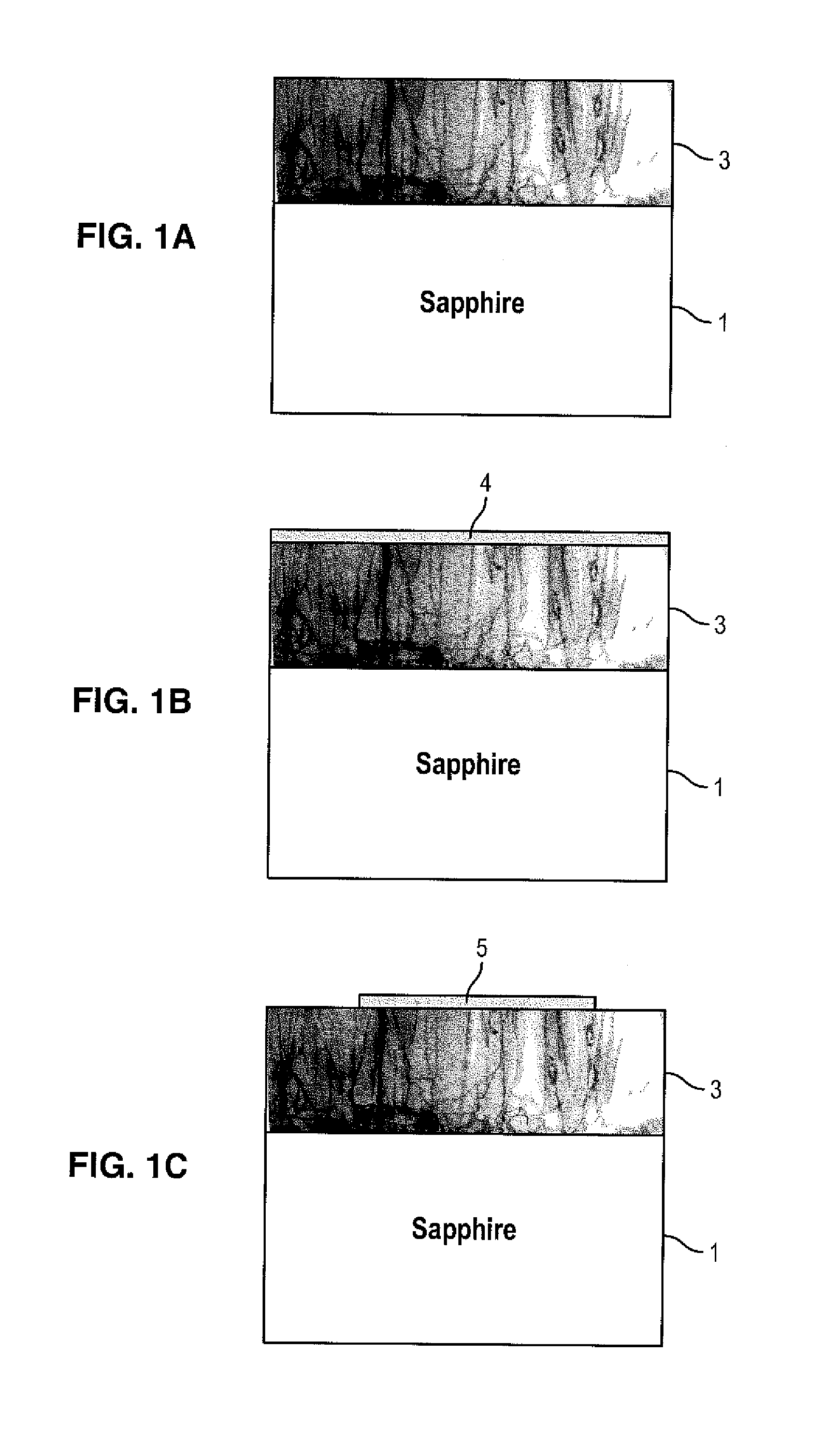Manufacturing of low defect density free-standing gallium nitride substrates and devices fabricated thereof
a gallium nitride substrate and low defect density technology, which is applied in the direction of crystal growth process, polycrystalline material growth, chemically reactive gas growth, etc., can solve the problems of gan not being melted, unable to grow low-defect density iii-n layers, and unable to meet the requirements of gan melted, etc., to reduce the defect density of the nitride crystal layer 103
- Summary
- Abstract
- Description
- Claims
- Application Information
AI Technical Summary
Benefits of technology
Problems solved by technology
Method used
Image
Examples
example 1
The Method of Manufacturing Such Substrates Comprises Several Steps as Schematically Shown on FIGS. 1 and 2
[0152]Epitaxial growth is carried out using preferably by Metal Organic Vapour Phase Epitaxy (MOVPE) for the fabrication of GaN pillars, even though other vapour phase epitaxy techniques such as Halide Vapour Phase Epitaxy (HVPE) and close space Vapour Phase transport (CSVT, also refereed as sublimation) can also be used.
[0153]The substrate 1 generally has a thickness of a few hundred μm (in particular approximately 300 μm) and may be chosen from the group consisting of sapphire, ZnO, 6H—SiC, 4H—SiC, 3C—SiC, Si, LiGaO2, LiAIO2, MgAI2O4, ZrB2, GaAs, HfB2, AIN, GaN, and advantageously is sapphire (0001).
[0154]The following paragraphs are directed to a preferred process to produce the GaN layer 3.
[0155]This process for producing a layer of gallium nitride (GaN) is remarkable in that it comprises the deposition on a substrate of a silicon nitride layer functioning as a nanomask and...
example 2
[0208]In example 2 however, after grooving the stripes to form pillars, the top mask 8 is not removed. Growth is allowed to restart in MOVPE.
[0209]As expected, growth starts from the {11-20} facets resulting from the RIE groove to finally coalescence into triangular stripes with {11-22} lateral facets as in example 1. The FIG. 8 schematically shows the evolution of the facets structure as growth proceeds.
[0210]At this stage, the structure is introduced in the multiwafer HVPE reactor and growth takes place according one of the variations described in example 1. After all the technological processes described in example 1, a free standing GaN wafer presenting TDs densities6 cm−2, that are uniformly distributed on the top Ga face surface is obtained. Indeed, once again, the HVPE step inducing multiple TD bendings results in a redistribution of TD at the coalescence boundaries from the MOVPE steps.
example 3
[0211]In example 3 the mask pattern for both the ELO process and the groove of pillars is a two dimensional array of hexagons (see FIG. 9A). The ELO GaN is grown as in example 1. When the first step of MOVPE ELO is achieved, a second mask consisting in an array of hexagons as shown in FIG. 9A is deposited exactly above the first one. Afterward RIE etching, a “honeycomb” structure is formed (see FIG. 8B). Conversely to previous examples, at this stage, etching can be achieved, at least partially, from the top surface. This will make the final separation easier.
[0212]These MOVPE / sapphire templates are introduced in a multiwafer HVPE reactor operating at low pressure, and the rest of the process follows previous examples. After all the technological processes described in example 1, a free standing GaN wafer presenting TDs densities6 cm−2, that are uniformly distributed on the top Ga face surface is obtained.
PUM
| Property | Measurement | Unit |
|---|---|---|
| thickness | aaaaa | aaaaa |
| operating life-time | aaaaa | aaaaa |
| thick | aaaaa | aaaaa |
Abstract
Description
Claims
Application Information
 Login to View More
Login to View More - R&D
- Intellectual Property
- Life Sciences
- Materials
- Tech Scout
- Unparalleled Data Quality
- Higher Quality Content
- 60% Fewer Hallucinations
Browse by: Latest US Patents, China's latest patents, Technical Efficacy Thesaurus, Application Domain, Technology Topic, Popular Technical Reports.
© 2025 PatSnap. All rights reserved.Legal|Privacy policy|Modern Slavery Act Transparency Statement|Sitemap|About US| Contact US: help@patsnap.com



